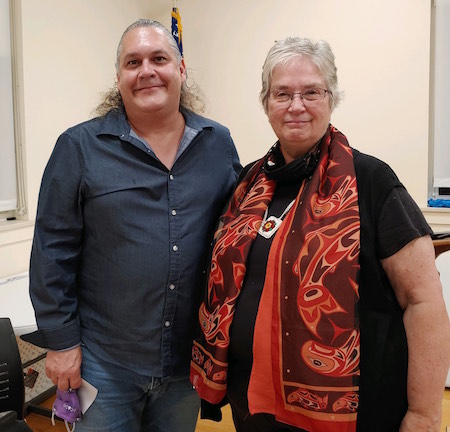Hoag presenters highlight injustices at Native American boarding schools from generations ago
Contributed by Bob Golden, member of Community Coalition for Justice

Photo courtesy of Kim Remley: Dr. Edward Koban and Kae Wilbert led a presentation last week at Hoag Library about Native American Boarding Schools.
ALBION – Hoag Library last week hosted a presentation “Native American Boarding Schools,” with Cherokee descendant Kae Wilbert at the helm. A full house of about 50 people attended the discussion on Sept. 22.
A retired school teacher, Mrs. Wilbert took us back to the times when white people became the dominating group in the Americas —we had guns, diseases we could withstand, but the indigenous did not and were decimated by them.
Many of the children died in these schools of unknown or unpublished reasons – 2,000 unmarked graves, anticipated to be more, were discovered recently by modern x-ray technology at a Canadian home. Mismarked graves have been discovered in the U.S. In one instance a burial site was moved to build a parking lot for a new military facility.
Also, white people attempted to convert the American Native children to “white ways,” to become workers for industrialists and agri-business. (By the way, agri-business was to a great extent about producing alcohol, tobacco and sugar – not food! and generally utilized the cheapest, most exploitable labor.)
From 1869 to the 1960s, hundreds of thousands “U.S. Native children that were voluntarily or forcibly removed from their homes, families, and communities during this time, were taken to schools far away…” so they couldn’t successfully run away to their families. (Many of them tried. Jim Thorpe, considered by Sports Illustrated, “America’s Greatest Athlete,” escaped several times and twice managed to get to his Oklahoma home.)
Nor could they have contact with home or visit and they didn’t. One attender told of their parents, being away from their home for 4 years, without any contact. Another mentioned supposition is that children may have died for “failure to thrive” as a result of separation from their mothers, families, siblings and community: a phenomenon we understand now.
The quote above from the National Native American Boarding School Healing Coalition above continues, “… they were punished for speaking their native language, banned from acting in any way that might be seen to represent traditional or cultural practices, stripped of traditional clothing, hair and personal belongings and behaviors reflective of their native culture.”
Mrs. Wilbert’s tone was not as harsh as this writer’s, but the harsh facts and provoking images (especially the children’s graveyards) from her films and the information were there.
What happened to many of these children in both the US and Canada is unpublished. There’s a current effort to go through records to discover and report on their fates.
Not surprisingly, given today’s unfortunate knowledge of such things, there are reports of these children being physically, sexually and emotional abused, in addition to their cruel separation from home and culture.
Kae Wilbert, Dr. Edward Koban and others, all Native American descendants, told about how their parents and relatives didn’t want to discuss their experiences at the boarding schools, they were so painful. One woman said that both of her parents were thankful for their training, Dad was a successful carpenter, Mom a cook, but also verified that they were allowed no contact with their families for the 4-5 years they were there.
Another woman and man told how if a Native American married outside their race, they were forced to leave their homes on the reservation, even if they were US war veterans. Another talked about a relative who worked at Kodak for several years, but only got several advancements, after he’d cut his long Native American hair and dressed white society-wise.
Dr. Koban also told of inter-generational research showing that grandchildren suffer panic attacks from the trauma their grandparents suffered in the boarding schools many years before.
Dr. Koban is offering a similar program at Taylor Theater, Keenan Center, Lockport,
On Nov. 16 at 6:30 p.m.
The next program at the Hoag Library on Race is Herb Smith of the Rochester Philharmonic presenting on Music and Race, Wednesday, October 27, at 6:30 p.m.
















































































